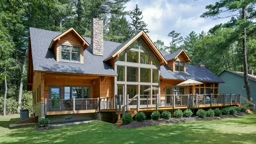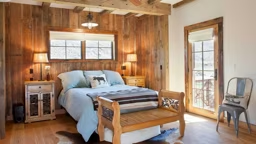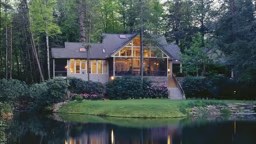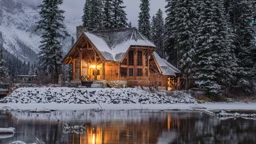
Photo: by James Ray Spahn / Home: Combined Timber Crafts
In the world of custom wood homes, log home maintenance is a hot topic; but what about timber-framed houses? What do you need to keep the timber components looking and performing their best? We sat down with Sam Ebersol, general manager of Mid-Atlantic Timberframes, to talk about the maintenance needs of these unique structures, and he offers his five best suggestions for properly caring for your home’s interior and exterior timber elements.
Design for Durability.
One of the more important things you can do is design large overhangs and porches to protect exposed timbers from rain and snow, as well as shade them from harmful UV rays. It’s also important to keep the wood posts or columns raised off of the concrete or flagstone floor. This prevents cracks from forming due to trapped moisture.
Prevent Pests.
For protection against insects, treat wood with a borate solution. This should be done before you oil or stain the wood.
Keep an Eye on It.
Regular structural inspections should be part of your maintenance routine. When exposed timbers start to fade, it is time to reapply another coat of stain. If you wait until the stain is completely broken down or faded, you have waited too long, and you’ll likely have to strip and start over.
An outdoor timber frame structure requires new stain every two to six years, depending on the amount of UV exposure it receives. If it’s not in direct sunlight, you may be able to wait five to six years; if the structure is in direct sun, you should stain every two to three years.
Note that not all parts of your timber home may require maintenance at the same time. For example, posts that are fully exposed to the sunlight will fade first. Rafters that are shaded from the sun may not need touch ups as regularly.
Pick the Right Products.
For an exterior timber frame, you need a product that aggressively repels water while still allowing the wood to breathe. There are a number of appropriate outdoor stains on the market today, ranging from natural-translucent to ultra-saturated colors. A “clear coat” is like a polyurethane finish or a tung oil finish, which are insufficient for UV protection but make a great second coat to give your timber a nice gloss and easy-to-clean surface.
For timber frame interiors, a natural oil finish, like a linseed or tung oil, is perfect protection and is easy to apply using a brush, rag or roller. Look for a product that’s wet enough for quick penetration but has enough solids for a rich, water-resistant coat. The oil finish helps with dusting because dust sits on the surface and does not seep into the wood, making it easier to clean.
Regulate Moisture.
Although you want to keep exterior timbers as dry as possible, on the inside of your home, low humidity is one of the biggest enemies a timber frame has. If you have forced air — heat or radiator — your interior air can be super dry. If humidity in the home is low, the timbers will be affected, even if they’re kiln-dried. Timbers essentially act like a living, breathing tree, especially in the first few years, and while your timbers acclimate to their new environment, they expand and contract. It’s important in a timber frame home to have a humidifier — not a dehumidifier — as part of your HVAC system. A humidifier can help keep humidity at a perfect level, and it’s a healthy-home enhancement, too.











